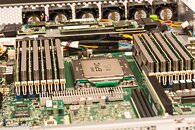Tuesday, February 25th 2020
Cloudflare Deploys AMD EPYC Processors Across its Latest Gen X Servers
The ubiquitous DDoS-mitigation and CDN provider, Cloudflare, announced that its latest Gen X servers implement AMD EPYC processors ditching Intel Xeons with its older Gen 9 servers. Cloudflare uses multi-functional servers (just like Google), in which each server is capable of handling any kind of the company's workloads (DDoS mitigation, content delivery, DNS, web-security, etc.). The company minimizes server hardware configurations so they're easier to maintain and lower TCO. The hardware specs of its servers are periodically updated and classified by "generations."
Cloudflare's Gen X server is configured with a single-socket 2nd gen AMD EPYC 7642 processor (48-core/96-thread, 256 MB L3 cache), and 256 GB of octa-channel DDR4-2933 memory, along with NVMe flash-based primary storage. "We selected the AMD EPYC 7642 processor in a single-socket configuration for Gen X. This CPU has 48-cores (96 threads), a base clock speed of 2.4 GHz, and an L3 cache of 256 MB. While the rated power (225 W) may seem high, it is lower than the combined TDP in our Gen 9 servers and we preferred the performance of this CPU over lower power variants. Despite AMD offering a higher core count option with 64-cores, the performance gains for our software stack and usage weren't compelling enough," Cloudflare writes in its blog post announcing Gen X. The new servers will go online in the coming weeks.Many Thanks to biffzinker for the tip.
Source:
Cloudflare Blog
Cloudflare's Gen X server is configured with a single-socket 2nd gen AMD EPYC 7642 processor (48-core/96-thread, 256 MB L3 cache), and 256 GB of octa-channel DDR4-2933 memory, along with NVMe flash-based primary storage. "We selected the AMD EPYC 7642 processor in a single-socket configuration for Gen X. This CPU has 48-cores (96 threads), a base clock speed of 2.4 GHz, and an L3 cache of 256 MB. While the rated power (225 W) may seem high, it is lower than the combined TDP in our Gen 9 servers and we preferred the performance of this CPU over lower power variants. Despite AMD offering a higher core count option with 64-cores, the performance gains for our software stack and usage weren't compelling enough," Cloudflare writes in its blog post announcing Gen X. The new servers will go online in the coming weeks.Many Thanks to biffzinker for the tip.



21 Comments on Cloudflare Deploys AMD EPYC Processors Across its Latest Gen X Servers
:laugh: :laugh: :laugh: :laugh: :laugh: :rolleyes:
It's likely a generic design they use for all systems. Some use more cables, some less.
The whole server looks a bit cheap and DIY, to be honest... :P
100g of Cu costs $8. Pennies.
Actual PSUs are modular - you slide them into that enclosure.
Inside there are 2 PSUs. You can see one through the gaps.
The 2 black objects I've marked are handles for pulling the PSUs out.
It's a hot swap redundant PSU, so you can replace one on a running server.
That would be quite challenging with fixed wires. :P
This is how it looks from the back (different model):
Not every rack unit needs such a robust power supply, but - given the nature of Cloudflare's services - I bet it's money well spent. :)
But I meant: relative to other global buyers of server hardware. Which was meant to explain why the server shown in photos screams "budget".
Cloudflare is a leader in a very niche market.
A CDN is usefull if your service is global to have a equal amount of speed or something but it does'nt make much sense if your local.